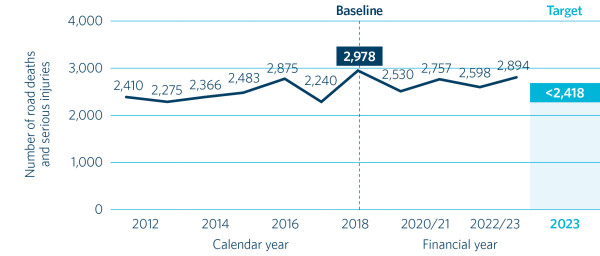Road to Zero is the national road safety strategy for a transport system where no one is killed or seriously injured.
There were 2894 deaths and serious injuries on the roads over the last year. This number remains unacceptably high. Despite some improvements, such as a reduction in deaths and serious injuries from crashes involving vehicles with low safety ratings and in crashes involving alcohol or other drugs, there were increases in many other types of crashes, including where the speed limit does not align with the safe and appropriate speed. Crash data shows travelling too fast for the conditions is consistently one of the highest contributing factors in fatal and serious injury crashes. The Safety Camera System Programme and Speed Management Programme will improve road safety by establishing a streamlined process for speed management that involves setting safer speeds and implementing a more effective approach to speed enforcement.

In March 2023, the government narrowed the focus of our approach to speed management to focus on the most dangerous 1 percent of state highways where there are the highest number of deaths and injuries and where communities support change. We are committed to Vision Zero and the targets set in Road to Zero and will continue to partner with communities to deliver road safety solutions that meet their needs.
As part of the Tackling Unsafe Speeds Programme, we are delivering a new approach to safety cameras. The transfer of existing cameras from New Zealand Police will start in July 2024, a year later than originally planned. The first stage, successfully completed in 2022/23, included setting up and testing a new safety camera prototype to ensure the equipment operated correctly with credible and robust detection performance.
We need a sustainable funding model if we are to do a good job as regulator. Following consultation with a range of stakeholders last year, in March 2023, Cabinet agreed to a new funding model for regulatory funding, fees and charges. The new funding model is based on people paying the right and fair amount for the services they are getting and will mean changes to 170 fees and charges. These changes are planned to be implemented from October 2023.
We refreshed Tū Ake, Tū Māia, our regulatory strategy, in 2022/23. To help us continue to improve as a regulatory steward, the refreshed strategy takes a whole-of-system approach and broadens the definition of regulation, recognising that all of Waka Kotahi plays an important part in delivering the organisation’s regulatory role. Tū Ake, Tū Māia will help guide our work for the next decade as we seek to become more visible, agile, responsive and decisive in our regulatory approach and actions.